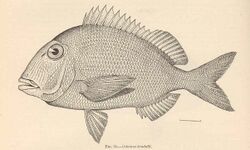Biology:Pluma porgy
| Pluma porgy | |
|---|---|

| |
| Scientific classification | |
| Domain: | Eukaryota |
| Kingdom: | Animalia |
| Phylum: | Chordata |
| Class: | Actinopterygii |
| Order: | Spariformes |
| Family: | Sparidae |
| Genus: | Calamus |
| Species: | C. pennatula
|
| Binomial name | |
| Calamus pennatula (Guichenot, 1868)
| |
The Pluma porgy (Calamus pennatula) is an ocean-going fish of the family Sparidae. In many parts of the Caribbean, it is simply known as the Pluma, while in Jamaica can be called the Pimento grunt,[1] and is sometimes called the West Indian porgy in the United States .[2] The Pluma porgy was described by Alphone Guichenot, a French zoologist who taught, researched, and participated in specimen collecting trips on behalf of the National Natural History Museum in Paris, in 1869.
Found only in the Atlantic ocean, Pluma porgies are the most common member of their genus in the Antilles, where they are often used for food[3]—though ciguatera poisoning has been reported as a result of this.[4]
Description
The Pluma porgy is similar to its relative, the Jolthead porgy (C. bajonado). However, it has fewer rays on its Pectoral fins than the Jolthead.[5] The Pluma porgy has both 12 spines and 12 soft rays on its dorsal fin, while it has only 3 spines and 10 rays on its anal fin.[6] Their heads are somewhat steep when viewed in profile, and have poorly developed prefrontal tubercles.[7] The Pluma porgy's overall color is silvery with purple, or lavender iridescence, individual scales have brown-yellow edges with iridescent, blue-green spots.[7]
Distribution and habitat
Pluma porgies inhabit are found only in the western Atlantic, in a region from the Bahamas to Brazil ; this includes much of the southern Caribbean and the Gulf of Mexico. Adults live at depths of up to 85 metres (279 ft), but usually between 5 to 30 metres (16 to 98 ft).[8] They inhabit rocky areas, reefs, and also flat bottoms,[3] where they feed on crabs, mollusks, sea worms, brittle stars and hermit crabs.[3] The young are found in somewhat shallower water.[3]
References
- ↑ Pollnac, R.B. 1998 Aspects of the human ecology of the coral reefs of Discovery Bay. p. 141-199. In R.B. Pollnac (ed.) Rapid assessment of management parameters for coral reefs. Coastal Resources Center, University of Rhode Island. CMR 2205, ICLARM 1445.
- ↑ Robins, C.R., R.M. Bailey, C.E. Bond, J.R. Brooker, E.A. Lachner, R.N. Lea and W.B. Scott 1991 World fishes important to North Americans. Exclusive of species from the continental waters of the United States and Canada. Am. Fish. Soc. Spec. Publ. (21):243 p.
- ↑ 3.0 3.1 3.2 3.3 Randall, J.E. and R. Vergara R. 1978 Sparidae. In W. Fischer (ed.) FAO species identification sheets for fishery purposes. Western Central Atlantic (Fishing Area 31). FAO, Rome. Vol. 5. pag.var.
- ↑ Olsen, D.A., D.W. Nellis and R.S. Wood 1984 Ciguatera in the Eastern Caribbean. Mar. Fish. Rev. 46(1):13-18.
- ↑ Bohlke, James E. Charles C. G. Chaplin. Fishes of the Bahamas and Adjacent Tropical Waters. 2nd edition. Austin, UP of Texas. 386.
- ↑ Froese, Rainer and Pauly, Daniel, eds. (2010). "Calamus pennatula" in FishBase. 01 2010 version.
- ↑ 7.0 7.1 Randall, J.E. 1996 Caribbean reef fishes. Third edition - revised and enlarged. T.F.H. Publications, Inc. Ltd., Hong Kong. 368 p.
- ↑ Cervigón, F. 1993 Los peces marinos de Venezuela. Volume 2. Fundación Científica Los Roques, Caracas,Venezuela. 497 p.
External links
Wikidata ☰ Q3751923 entry

